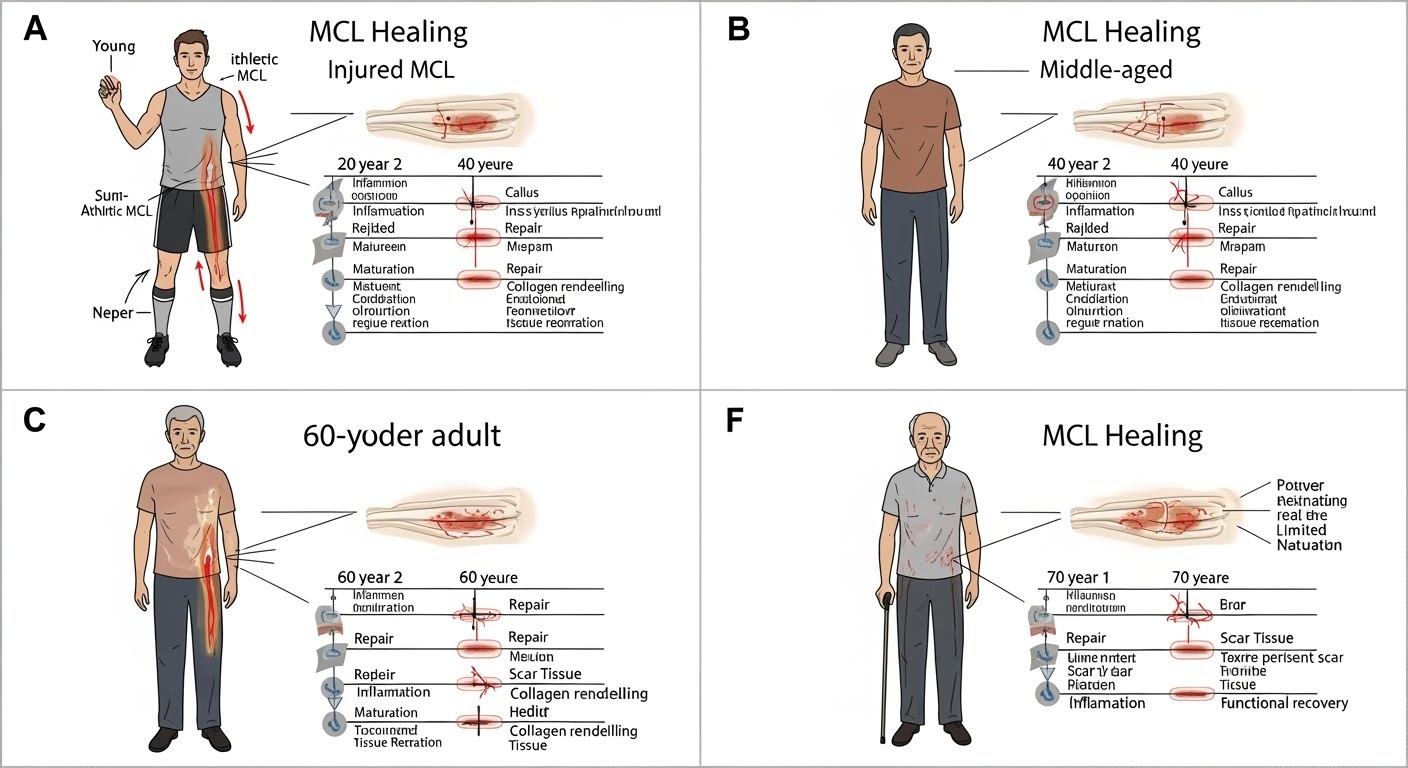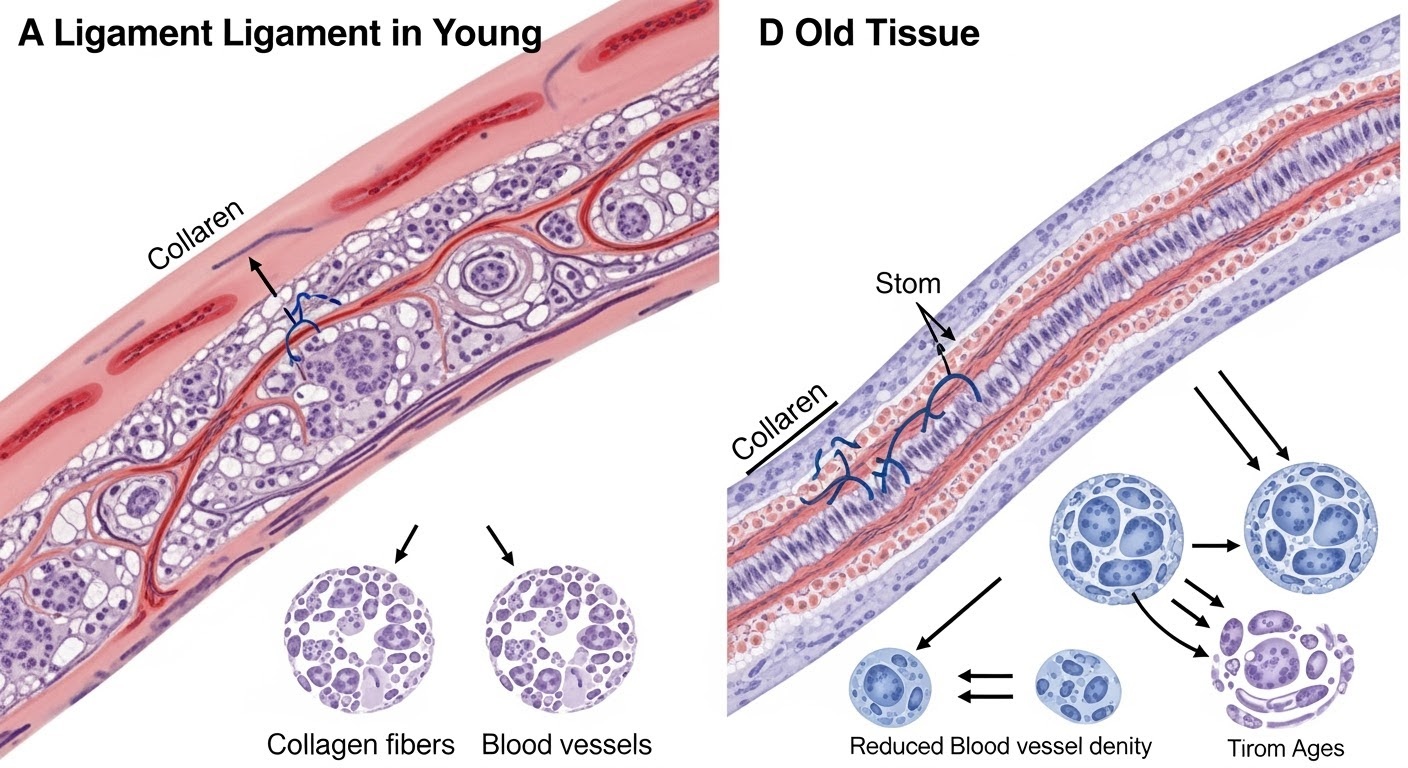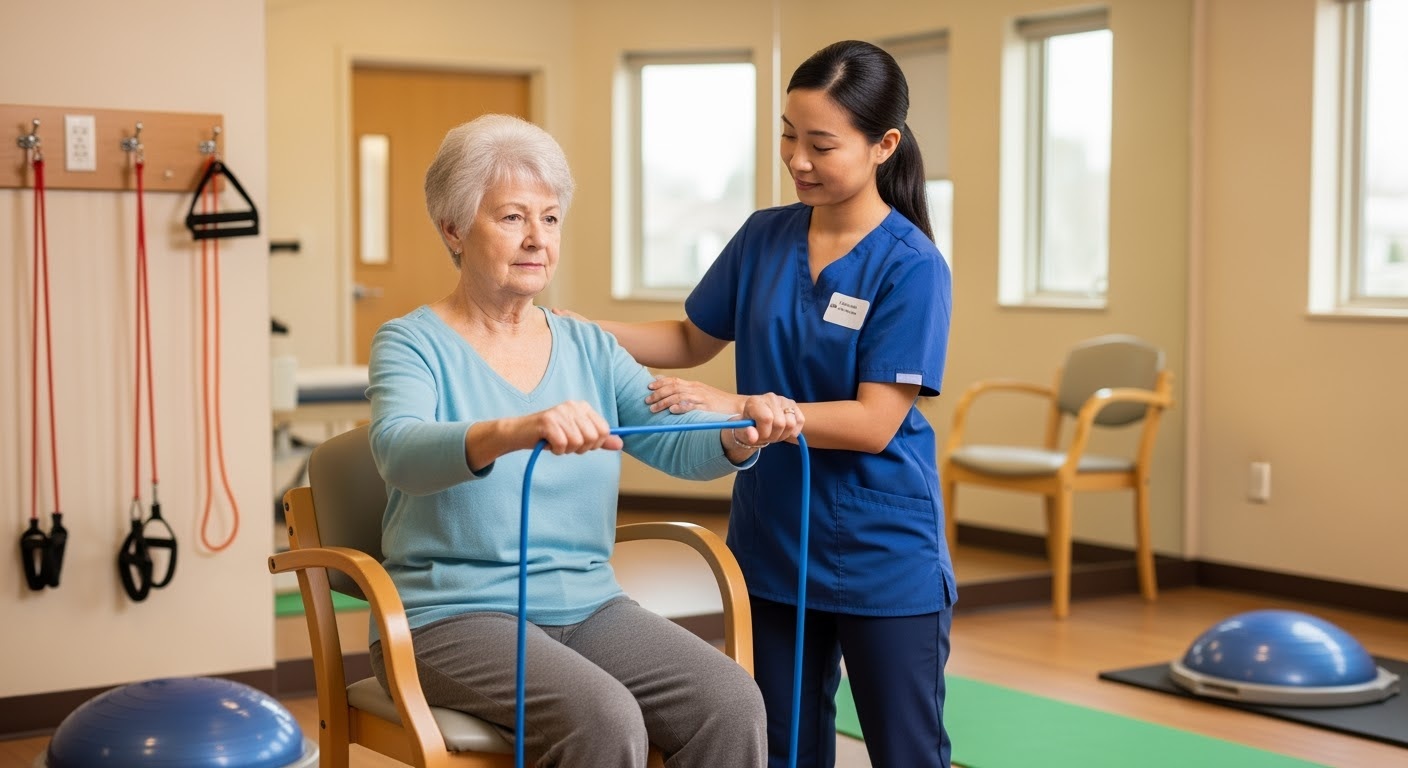Published: May 23, 20258 min read Physical Therapy Expert
Understanding how age affects MCL sprain recovery is crucial for setting realistic expectations and optimizing your healing process. This comprehensive guide reveals the science behind age-related healing differences and provides actionable strategies for every life stage.
Quick Fact: A 25-year-old athlete can recover from a Grade 2 MCL sprain in 3-4 weeks, while a 65-year-old may need 8-10 weeks for the same injury. This isn’t just about being “older” – it’s about fundamental biological changes that occur throughout our lives.

Age is one of the most significant yet misunderstood factors affecting MCL sprain recovery. While we often hear that “healing takes longer as you get older,” the reality involves complex biological processes that change predictably throughout our lifespan. Understanding these changes empowers you to work with your body’s natural healing mechanisms, regardless of your age.
As a physical therapist with three decades of experience treating MCL sprains across all age groups, I’ve observed remarkable variations in healing patterns. However, I’ve also seen patients defy age-related expectations through targeted interventions and optimized recovery strategies.
This guide will explore the science behind age-related healing differences, provide specific timelines for different age groups, and offer practical strategies to maximize your recovery potential at any stage of life.
Understanding Age-Related Healing Changes
Watch this educational video to understand how cellular changes, collagen production, and healing speed vary across different age groups.
The Science of Aging and Tissue Healing

To understand why age affects MCL healing, we must examine what happens at the cellular level as we grow older. These changes are gradual but cumulative, creating increasingly noticeable effects on recovery time and quality.
Cellular Regeneration Changes
Young tissues contain abundant stem cells and growth factors that rapidly respond to injury. As we age, several key changes occur:
- Stem Cell Decline: The number of mesenchymal stem cells decreases by approximately 10% per decade after age 30
- Growth Factor Reduction: Production of healing-promoting growth factors drops significantly
- Cell Division Slowing: Cellular mitosis becomes less efficient, extending tissue replacement times
- DNA Repair Efficiency: Cellular repair mechanisms become less precise and slower
Collagen Production Decline
Collagen forms the structural backbone of ligaments like the MCL. Age-related changes include:
- Quantity Reduction: Collagen synthesis decreases by 1-2% annually after age 25
- Quality Changes: New collagen becomes less organized and mechanically weaker
- Cross-Linking Alterations: Abnormal cross-links form, reducing tissue flexibility
- Type Ratio Shifts: The ratio of different collagen types changes, affecting tissue properties
Blood Flow Modifications
Vascular changes significantly impact healing speed:
- Microcirculation Decline: Smaller blood vessels become less efficient at delivering nutrients
- Angiogenesis Reduction: The ability to form new blood vessels decreases
- Oxygen Delivery: Reduced hemoglobin efficiency affects tissue oxygenation
- Waste Removal: Metabolic waste clearance becomes less efficient
Age-Specific Recovery Timelines
MCL Recovery Time by Age Group
- Grade 1: 5-10 days
- Grade 2: 2-3 weeks
- Grade 3: 4-6 weeks
Peak healing capacity with optimal cellular function and maximum growth factor production.
25-40: Optimal Recovery Window
- Grade 1: 7-14 days
- Grade 2: 3-4 weeks
- Grade 3: 6-8 weeks
Excellent healing with maintained cellular function, though slightly slower than youth.
40-55: Transitional Phase
- Grade 1: 10-18 days
- Grade 2: 4-6 weeks
- Grade 3: 8-12 weeks
Noticeable slowing of healing processes, increased importance of optimization strategies.
55+: Extended Healing Requirements
- Grade 1: 14-28 days
- Grade 2: 6-10 weeks
- Grade 3: 12-20 weeks
Significant healing delays, require patient approach and comprehensive optimization.
Physiological Changes by Decade
Healing Capacity Decline Over Time
20s-30s
- • Peak collagen production
- • Optimal blood flow
- • Maximum growth factors
- • Excellent cell division
40s-50s
- • 25% collagen reduction
- • Decreased circulation
- • Hormonal changes
- • Slower cell renewal
60s+
- • 50% collagen reduction
- • Compromised circulation
- • Multiple system changes
- • Extended healing phases
Age-Adapted Treatment Protocols
Young Athletes: Aggressive Rehabilitation
- Week 1-2: Early mobilization with pain-guided activity
- Week 2-3: Progressive strengthening and range of motion
- Week 3-4: Sport-specific movement patterns
- Week 4+: Return-to-play testing and clearance
Seniors: Gentle Progression
- Week 1-3: Protected motion with support devices
- Week 3-6: Gradual strength building with assistance
- Week 6-10: Functional activity training
- Week 10+: Maintenance and injury prevention
Treatment Protocol Comparison Table
| Age Group | Initial Approach | Exercise Intensity | Progression Rate | Special Considerations |
|---|---|---|---|---|
| Under 25 | Immediate mobilization | High intensity | Rapid (daily changes) | Prevent overconfidence |
| 25-40 | Early controlled motion | Moderate-high | Steady (every 2-3 days) | Work-life balance |
| 40-55 | Cautious early motion | Moderate | Gradual (weekly) | Hormonal factors |
| 55+ | Protected motion | Low-moderate | Very gradual | Comorbidities, fall risk |
Age-Optimized Recovery Tips
For Younger Patients (Under 40)
- Leverage your healing advantage: Use early aggressive rehabilitation to prevent long-term complications
- Don’t rush return to activity: Complete healing prevents future problems
- Focus on movement quality: Develop proper patterns for lifelong joint health
- Invest in injury prevention: Build strength and flexibility for future protection
For Older Patients (40+)
- Optimize nutrition: Increase protein intake and anti-inflammatory foods
- Prioritize sleep quality: 7-9 hours supports healing hormone production
- Manage chronic conditions: Control diabetes, blood pressure, and inflammation
- Consider supplementation: Vitamin D, omega-3s, and collagen support
Universal Age-Friendly Strategies
Hydration Protocol
Half your body weight in ounces of water daily, plus 16-20oz for every hour of therapy
Stress Management
Practice meditation, deep breathing, or gentle yoga to reduce cortisol levels
Temperature Therapy
Alternate ice (15 min) and heat (20 min) to optimize circulation and pain relief
Success Stories Across Age Groups
Sarah, Age 22
College Soccer Player
Injury: Grade 2 MCL sprain during practice
Timeline: Returned to full play in 18 days
Key Factors: Immediate treatment, daily PT, excellent compliance, and youthful healing capacity
Michael, Age 45
Weekend Tennis Player
Injury: Grade 2 MCL sprain from awkward fall
Timeline: Returned to tennis in 6 weeks
Key Factors: Nutrition optimization, stress management, and modified activity schedule
Eleanor, Age 68
Active Grandmother
Injury: Grade 1 MCL sprain from gardening
Timeline: Returned to activities in 5 weeks
Key Factors: Patient approach, fall prevention focus, and family support system
Your Age-Optimized Action Plan
Immediate Steps (First 48 Hours)
All Ages:
- • Apply RICE protocol immediately
- • Seek professional evaluation
- • Begin gentle range of motion
- • Start anti-inflammatory nutrition
Age-Specific Additions:
- Under 40: Early mobilization focus
- 40-55: Comprehensive health assessment
- 55+: Fall prevention evaluation
Week 1
Protection and early motion
Weeks 2-4
Progressive strengthening
Weeks 4-8
Functional training
Weeks 8+
Prevention and maintenance
Conclusion: Age is Just One Factor
While age significantly impacts MCL sprain healing duration, it’s not destiny. Understanding your body’s changes at different life stages empowers you to optimize your recovery process and achieve the best possible outcomes.
Remember these key principles:
- Earlier intervention always produces better results, regardless of age
- Consistent adherence to age-appropriate protocols is more important than aggressive treatment
- Optimizing nutrition, sleep, and stress management can significantly offset age-related delays
- Setting realistic expectations prevents frustration and promotes better compliance
Whether you’re a 20-year-old athlete or a 70-year-old staying active, your MCL sprain can heal successfully with the right approach. The key is working with your body’s current capabilities while optimizing every factor within your control.
Your age doesn’t define your recovery—your commitment to evidence-based healing strategies does. Start implementing these age-optimized approaches today, and give your MCL the best chance to heal completely and prevent future injuries.
About the Author
With over 30 years of experience as a physical therapist specializing in sports medicine and orthopedic rehabilitation, I’ve helped thousands of patients recover from MCL sprains across all age groups. My evidence-based approach combines traditional rehabilitation principles with cutting-edge recovery strategies.
My practice focuses on age-appropriate treatment protocols that maximize healing potential while respecting the unique needs and limitations of different life stages.


